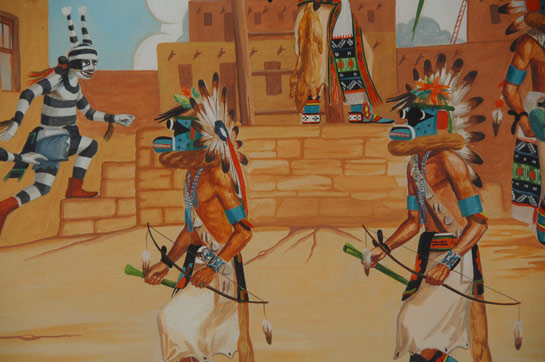Hopi Painting of a Plaza Dance with A’hote Katsinas & Koshare [SOLD]
+ Add to my watchlist Forward to Friend
- Category: Paintings
- Origin: Hopi Pueblo, Hopituh Shi-nu-mu
- Medium: casein
- Size: 14-1/2” x 19-1/2” image; 20” x 27” framed
- Item # C3442A SOLD
Hopi Pueblo artist Raymond Naha was born at Polacca, which is at the foot of First Mesa, on the Hopi Reservation in Arizona on December 5, 1933. He studied with Fred Kabotie at Oraibi High School. Kabotie recognized Naha's talent and encouraged him to continue his studies. Naha then took correspondence courses and studied at the Phoenix Indian School. His paintings are characterized by the depiction of details of Hopi ceremonial life in a vibrant and colorful manner. His work reflects more of a European influence than other Native American painters of the time. He was one of the first to break away from the traditional Dorothy Dunn style and use more colors and diverse backgrounds.
 Naha favored painting scenes of Katsina dances. In doing so, he provided a detailed ethnographic record of Katsinas in frontal, profile and back positions giving views of costuming from every direction. This painting of four A’hote Katsina dancers provides the viewer with full views of the dancers and their clothing. Not only is this artistic, it is a good record of costume use.
Naha favored painting scenes of Katsina dances. In doing so, he provided a detailed ethnographic record of Katsinas in frontal, profile and back positions giving views of costuming from every direction. This painting of four A’hote Katsina dancers provides the viewer with full views of the dancers and their clothing. Not only is this artistic, it is a good record of costume use.
A’hote Katsinas may appear in any of the directional colors. In this painting, they are the blue or Sakwahote Katsinas. The two Koshare appear to be tormenting the Katsinas and the lead A’hote Katsina looks as if he is going after them as they run away.
The A’hote Katsina dress appears to be influenced from Plains Indian culture, particularly the buckskin skirt and full feather headdress. In this presentation, three of the Katsinas carry a yucca leaf and one carries a gourd rattle.
Condition: original condition
Provenance: from the collection of Katie Noe (1905-1998) of Gallup. NM. Noe worked for the finest Indian dealers in Gallup for 20 years—C. N. Cotton, Gross-Kelly, Charles Ilfeld, Gallup Mercantile, and C. G. Wallace—before opening her own Indian shop “the Zuni Shop” which she operated until her health failed.
Recommended Reading: Southwest Indian Painting: A Changing Art by Clara Lee Tanner

- Category: Paintings
- Origin: Hopi Pueblo, Hopituh Shi-nu-mu
- Medium: casein
- Size: 14-1/2” x 19-1/2” image; 20” x 27” framed
- Item # C3442A SOLD



